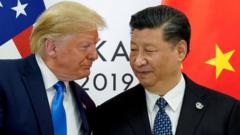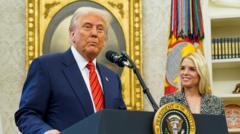President Donald Trump has declared that the United States and China have finalized a deal concerning rare earth metals, including magnets, as part of a broader effort to alleviate ongoing trade tensions. The agreement, announced via his platform Truth Social, awaits final approval from both Trump and Chinese President Xi Jinping. This declaration comes after intense discussions held in London aimed at resolving conflicts that arose since a prior truce in May.
Trump Declares Rare Earths Deal with China "Done"

Trump Declares Rare Earths Deal with China "Done"
In a recent announcement, President Trump confirmed a significant agreement with China regarding rare earth metals, following two days of high-stakes negotiations in London.
The negotiations commenced after Trump and Xi spoke by phone, prompting the involvement of senior officials from both nations. While the specifics of the deal remain unclear, it is said to uphold the existing framework established during the May truce, which sought to ease the strain of recent tariff escalations. China's Vice Commerce Minister, Li Chenggang, confirmed that both sides have reached an agreement in principle, while U.S. Commerce Secretary Howard Lutnick labeled the current momentum as positive, signaling progress in the negotiations.
The urgency for these talks stemmed from U.S. concerns over China's delays in exporting vital materials critical for manufacturing technologies such as smartphones and electric vehicles. Conversely, China has voiced concerns regarding U.S. restrictions on semiconductor access and proposed visa limitations on Chinese students. Although Lutnick noted some U.S. counter-measures would be lifted, he refrained from detailing these changes, stressing that a comprehensive deal would require further negotiation.
The backdrop to these discussions includes President Trump's introduction of high tariffs aimed primarily at Chinese imports, which spurred reciprocal measures from Beijing. A temporary resolution was reached in May, allowing both countries a 90-day window to negotiate further commitments to free trade. However, the recent communication indicated that any real resolution is still a long way off, with commentary from market observers suggesting that the current deal lacks substantial depth and does not signal an imminent trade reapproachment.
As the world awaits further developments, the implications of this newly declared agreement could shape future interactions and economic policies between the two superpowers.
The urgency for these talks stemmed from U.S. concerns over China's delays in exporting vital materials critical for manufacturing technologies such as smartphones and electric vehicles. Conversely, China has voiced concerns regarding U.S. restrictions on semiconductor access and proposed visa limitations on Chinese students. Although Lutnick noted some U.S. counter-measures would be lifted, he refrained from detailing these changes, stressing that a comprehensive deal would require further negotiation.
The backdrop to these discussions includes President Trump's introduction of high tariffs aimed primarily at Chinese imports, which spurred reciprocal measures from Beijing. A temporary resolution was reached in May, allowing both countries a 90-day window to negotiate further commitments to free trade. However, the recent communication indicated that any real resolution is still a long way off, with commentary from market observers suggesting that the current deal lacks substantial depth and does not signal an imminent trade reapproachment.
As the world awaits further developments, the implications of this newly declared agreement could shape future interactions and economic policies between the two superpowers.





















